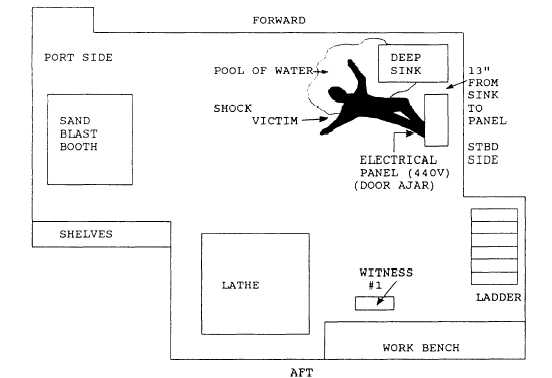| |
Figure 4-3.—Sketch of mishap scene.
Use a pen or pencil to draw arrows to parts of the
photograph you wish to draw attention to.
Take wide-angle shots as well as close-ups.
Identify your photo by including a photo log,
slate, or card in the photo with a code or number
or some other method of identification.
Label each photo according to your log or record,
telling when it was taken, who took it, under what
conditions it was taken, where it was taken from, and
what it shows. Otherwise, you may end up with a photo
of a jumble of wires and twisted metal with no clue as
to what the photo is of. It is embarrassing to leaf through
a stack of photographs and not even know which angle
is up!
VIDEOTAPING.— Videotaping is a valuable
method of recording a mishap scene, but it is not a
substitute for still photography. A video tape shows
responders in action and shows movement and color;
but it cannot be studied as well as a photo.
Recording a reenactment of the chain of events
leading to a mishap can serve as a valuable supplement
to still photography. A videotape made by an afloat or
aviation mishap investigation board to reenact a mishap
is privileged, since the tape reflects the board’s
deliberations.
passersby, or
Other video tapes made by reporters,
a single investigator are not privileged
since they are physical evidence.
SKETCHING, DIAGRAMING, AND CHAR-
TING.— A sketch is a drawing made at a mishap site. It
is usually a rough, stylized drawing that can be
smoothed up later into a more accurate diagram. Charts
are usually tables of information, measurements, or
statistics used to clarify certain points. You may also
have charts of speeds, instrument readings, and
temperatures.
The same rules that apply to the labeling of
photographs apply to the labeling of sketches and
diagrams (fig. 4-3). Carefully label sketches and
diagrams as you would a photograph. The advantage
that a diagram has over a photograph is that it is less
cluttered. A diagram can show movement with arrows,
angles, positions of people and parts, and key distances.
Drawn closely to scale, it can emphasize certain aspects
of a photograph to clarify a point. Sketches may be the
only evidence you have from a mishap scene if
photographs were not available before evidence was
moved.
With a sketch or diagram, you can add information
like temperatures, air flow, plots of noise, and lighting.
4-10
|

